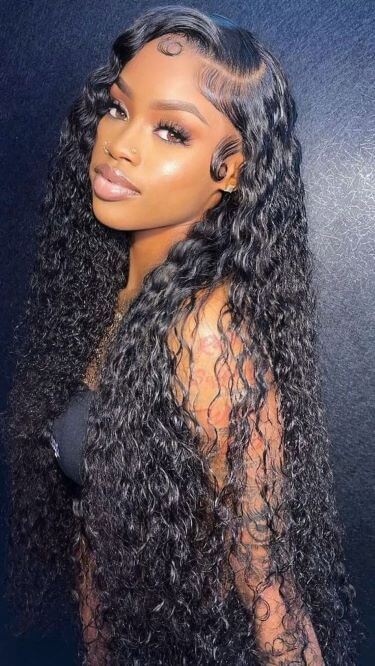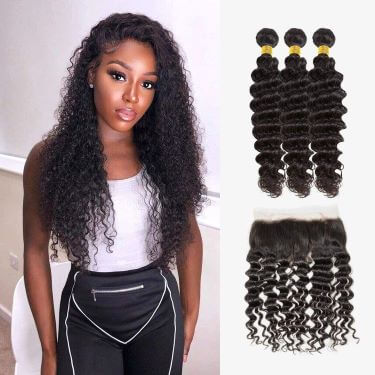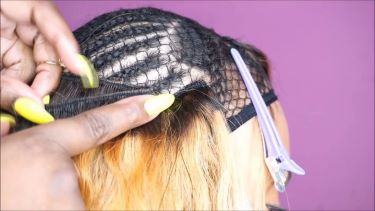Wig vs weave, which one will you choose?
They are common and popular options for hair transformations. How to figure out which is the best to fit you? In this article, we will show you the difference between them and guide you to choose the right option.
So let’s start to get into it!

What are Wigs?
A wig is an artificial covering of our natural hair. Wigs usually cover most of our hair and can be easily worn on and off, kind of like a hat. They are usually made of synthetic fibers, animal hair, or natural human hair.
A wig is a great daily accessory for anyone who wants to cover or change their hairstyle. It can help those with hair loss to cover their entire head and maintain confidence and beauty. It also allows those with short hair to try a long hairstyle or switch to different styles.
In addition, people may also wear wigs for cultural traditions or religious reasons.
Different Types of Wigs
Nowadays, there are many avoidance fine wigs. The most natural and trendy wigs tend to come with lace. Depending on the size of the internal lace area, there are full lace wigs, lace front wigs, T-part lace, etc.
Full lace wigs have a cap fully made of lace. It is perhaps the most realistic type of wig that provides style flexibility. For the front lace wig, the lace area is from ear to ear, creating a natural-looking hairline. For T-part lace wigs, as the name suggests, the lace area has a “T” shape that is easy to put on.
We can choose any one we like with different wig types, lengths, colors, and constructions.

Pros of Wigs
Now, let’s summarize some pros and cons of wearing wigs to have some additional insights.
Natural Looking
Wigs enable us to cover our entire head, which gives a realistic look. They help people with thinning hair or balding to boost confidence and their social life.
Versatility
Instead of changing our natural hair, we can choose a wig to suit any occasion. We can even combine different colors, lengths, and lace in different ways to create infinite styles!
Protection
Wearing a wig is a useful way to protect weak hair from heat styling, sun damage, dry air, and chemicals. It can also allow damaged hair some time to recover.
Easy Application
They are seamless to put on and take off. There are also many types of wigs for us to try on, so we can change into new styles in minutes.

Cons of Wigs
Like every coin has two sides, wigs also have some disadvantages.
Potential Discomfort
Some people may complain that wigs make their scalps feel stuffy and uncomfortable. The main reason is that some wigs may not be so breathable and are prone to damage after extended wear.
Maintenance Challenges
Maintaining wigs also takes lots of time and effort. Wigs, especially those made of synthetic fibers, are easy to get tangled if not well cared for
It’s better to remove them daily before sleeping or showering, which can be time-consuming.
Quality Variety
Wig quality tends to vary greatly depending on the material. Low-quality or synthetic wigs will appear unnatural. Some low-quality wigs may easily be off which can lead to embarrassing situations.
What are Weaves?
Weaves are a kind of hair extension that is woven directly into our natural hair. They are usually made of threads, yarns, strips, fibrous materials, or human hairs. Compared to the simplicity of wigs, weaves require to be sewn in with our braids or hair bundles.
People may wear wigs for many reasons, but weaves are usually for ladies who want to boost their appeal and sense of fashion. Weaves can be designed to fit any style, whether straight or curly, short or long.
Except for the above reasons, weaves can also be used to add volume to our hair. So, for people who have hair loss or breakage problems, they are a huge boost!

Different Types of Weaves
Weaves also have many varieties to choose from, such as sew-in, glue-in, hot fusion, etc.
Sew-in weaves are probably the most popular ones. They usually require sewing hair into our braids by a professional hairdresser.
Unlike sew-in weaves, glue-in weaves are much easier to apply and can easily be done at home. With particular glues and tools, we can adhere the weaves to our hair wefts. But, these simple weaves can only last about 2-3 weeks, after which you will need to reapply them.
Hot fusion weaves usually use keratin glue to attach weaves to every strand of our hair. This makes our hair looks more natural and easier to maintain long term.
Pros of Weaves
For weaves, there are also many pros and cons for us to know about.
Natural Appearance
Weaves seamlessly integrate with our existing hair, which makes them easy to blend in. This leads to a more natural appearance.
Low Commitment
Weaves enable us to change our hairstyle with low commitment. Instead of cutting or waiting for our hair to grow, we can try on weaves of any length, volume, and color.
Easy to Maintain
Weaves are much more secure once they are sewn to our natural hair. Thus, they are not likely to fall out and we don’t have to spend much time to maintain and care for them.

Cons of weaves
If you are considering having weaves, you should also be sure of the following cons.
Risk of Hair Damage
For weaves, an improper application like braiding hair too tight can cause hair loss. Additionally, wearing low-quality weaves can result in tangles and hair damage.
Painful Installation
Installing weaves is hard work, even for an experienced stylist. They often will cornrow the hair very tightly to secure them, which will be painful for many people.
Not for Everyone
Weaves are not friendly to people with thinning hair or complete hair loss. They also don’t pair well with active and athletic lifestyles. We can imagine how unpleasant the smell will be after sweat mixes in with weaves.
The Difference Between Wigs and Weaves
In this part, we’ll look at some major differences between weaves and wigs.
Construction
Wigs are designed to be worn and removed daily, so they can not be secured as tightly as weaves. They are usually constructed with caps to cover our entire scalp.
Meanwhile, weaves are sewn or glued to our natural hair very tightly. By doing this, weaves can usually last for weeks without worrying about slipping.
The duration of both wigs and weaves depends on how well they are secured and maintained. Usually, wigs can last several months while weaves need to be replaced after only a few weeks. Furthermore, human wigs will last longer than synthetic wigs.
Convenience
Wigs and weaves also have many differences in the installation process. For wigs, we just need to flatten our hair before putting on the spandex cap and then the wig. The time for installation is quite short and can easily be done daily.
By contrast, weaves require more time to install and usually require the help of stylists. The process starts with flattening our hair braid. Then sewing the hair extension and thread to the flattened base often requires lots of time.
If we want to remove wigs, it only takes a few moments with simple effort. For weaves, we need to be more careful to cut away all of the thread and get rid of each hair fiber. This part takes quite a long time and can cause damage to our natural hair.
Comfort
People may think that wearing wigs reduces the breathability of our natural hair. However, wigs are not as tight as weaves that are sown to our hair. In addition, there is not enough airflow to our scalps through tight braids underneath the weave.
So, if you prefer more breathability, wigs may surprisingly be a better choice!
Waves may be more painful when we first install them. But they are relatively comfortable for daily wear. Wigs, however, will usually cover our entire head and may lead to discomfort on the scalp or hairline.

Versatility
Wigs and weaves can both help us experiment with endless hairstyles and looks. They come in a variety of styles, colors, and lengths. In this respect, they don’t have much difference from each other.
Weaves are secured with threads and other tight methods, so it is not possible to change quickly. As for wigs, they can be worn on or off, any time of day, and anywhere we like. For example, we can change a straight wig to a curly bob wig while traveling to get a different feel!
Impact on Natural Hair Health
As we know, wigs and weaves are not designed for protecting or promoting hair growth. Yet, wearing a wig may help protect weak natural hairs from heat or sun damage. Weaves, on the other hand, have zero protection.
Wearing both wigs and weaves can result in scalp or hair damage if they are not well cared for. Wigs are more likely to cause traction alopecia and hairline recession. While weaves can lead to hair breakage or loss as the sewing process can be too tight.
Choosing the Right Option for You
Since wigs and weaves both have their pros and cons, it is difficult to choose which one suits you best. To make the final decision, we can consider the following guidelines.
Lifestyle
Our lifestyle and types of daily activities are key in the decision-making process. If you are a gym rat, a wig is the better option as sweat mixed with weaves will lead to an unpleasant smell. But if you like to swim, then weaves are the right option for you!
If you want to alternate your hairstyle look every day, then wearing wigs will give you more options. Yet, if you like to keep a classic style for weeks or months then weaves may be better for you.

Desired Look
For those trying wigs or weaves for the first time, the final look may not come out as desired. Variety in quality and construction may lead to a huge discrepancy in appearance. Some may feel they appear too shiny and not so natural, while others may think it’s not shiny enough.
To avoid this disappointing experience, wigs may be a better starting point to check your appearance right away.
Cost Considerations
The price for both wigs and weaves comes down to quality. Wigs can cost from tens to several thousand dollars. Expensive wigs are usually made of human hair from well-known brands. More expensive ones can last for years with proper maintenance.
For weaves, we usually start with an upfront investment of several hundred dollars. There is also an extra installation fee of around $100-$150.
Aside from the initial cost, the long-term maintenance expenses should also be taken into consideration. For this part, weaves are usually more costly than wigs. We may need to return them to the salon for maintenance or repeated installations.
Seeking Expert Opinions
After all the suggestions above, some people may still have trouble deciding. If that’s you, don’t hesitate to seek professional advice from experts and hairdressers.
Their rich knowledge and experience can provide direct guidance. Furthermore, they can also help us avoid unpleasant mistakes.
Wig vs Weave? To Have A Try!
In short, wigs and weaves can benefit our hairstyles in many ways. They both have different pros and cons depending on our lifestyle and requirements. It’s never too late to try them out and experience amazing hair transformations.
The choice between wigs or weaves is up to our preferences and hair conditions. No matter what we decide, remember that keeping proper care and maintenance will make both of them last longer.






